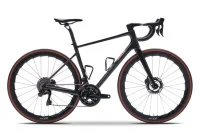Wheel Size Considerations
A version![]() of this article was originally
of this article was originally
published in Triathlete Magazine
I’m getting a new bike and am wondering what the differences between 650c and 700c wheels are? My road bike riding friends tell me to get 700c because they are faster. However, I’m 5’3” and many bikes in my size seem to have 650c. Thanks for the help.
Sharon , NY
Dear Sharon,
Wheel size is a common decision many athletes face when purchasing a new bike. I’ll focus on providing an overview of the primary differences that are usually brought up and how they relate to bike sizing and performance.
Aerodynamics and Weight – 650c wheels have less surface area and material than 700c and thus are arguably a bit more aerodynamic and lighter on their own. However, 650c equipped frames usually have taller head and steerer tubes than 700c, and thus 650c frames can sometimes be a little less aerodynamic and slightly heavier. When you consider both the frame and wheels together, most of these potential differences cancel each other out. Furthermore, the product’s weight and aerodynamics pale in comparison to the rider’s own weight and aerodynamics, so I would not base a wheel size decision on either of these variables.
Rolling Resistance – A wheel’s rolling resistance is determined by the amount of energy required to overcome the friction between the tire and the ground. It is often mistakenly generalized that narrower tires reduce rolling resistance. In reality, rolling resistance has more to do with the consistency of a tire’s contact patch with the ground than its width. Spreading an impact across a greater tire contact area reduces the impact’s ability to slow the tire’s momentum and thus reduces rolling resistance. Because 700c wheels have longer contact patches with the ground than 650c, they will usually have slightly less rolling resistance. Likewise, very narrow tires can actually have greater rolling resistance than slightly wider tires because narrower tires have less rubber contacting the ground and are thus not able to absorb bumps and other road imperfections as well.
Stiffness & Comfort – 650c wheels use smaller diameter (and thus stiffer) rims than 700c and are often built with shorter (stiffer) spokes. In general, this can make a 650c wheel a bit stiffer than the same model in 700c. While stiffer wheels usually are more reactive and responsive than more flexible wheels, they can also transmit more road shock to the rider. In the end, you want to find a balanced mix of comfort and stiffness by matching your frame, components and wheels to your individual needs and wheel size can be a small component in this equation.
Acceleration and Gearing – It has been stated that 650c wheels accelerate better than 700c. In a given gear combination, a smaller 650c wheel will be effectively geared lower, and will revolve more rapidly per pedal stroke, than a larger 700c wheel. This can create the illusion that a 650c wheel accelerates and climbs quicker, but the reality is that the acceleration difference is caused by an effective gear inch difference and not the wheel size itself.
Off the dealer’s floor, most stock 650c bikes are effectively geared lower than 700c as they often come with the same chainring and cassette combinations. This can make it easier to pedal a 650c bike up hills, but can sacrifice some top end gearing in the process. This being said, by altering chainring and cog ratios, similar effective gear inch ranges can be created on either wheel size. A gear inch chart shows this difference in detail.
Shifting Quality – Variables such as chainstay length, gearing, cable routing, and front derailleur angle can all play a role in how smooth, consistent and quiet a bike’s drive train operates. While the most important variable in shifting quality is the frame manufacturer’s attention to detail and component specifications, because Shimano and Campagnolo both design their components to work optimally on 700c frame dimensions, the average 700c bike tends to shift a bit quieter and more consistently than 650c.
Wheel, Tire and Tube Options – While there are some excellent 650c wheel, tire and tube options available, 700c wheels have more options simply because there are more bike models produced in 700c.
Rider Proportion, Handling and Stability – Each wheel size has its merits and limitations and none of the differences explained above on their own should be enough to sway most riders one way or another. What should sway you? By far, the most important variable in choosing a wheel size is to make sure it is proportionate to your size and to make sure any bike as a whole fits your optimal riding position well. While there are periodic exceptions, here are some guidelines to follow:
Riders under 5’2” – 650c will work best for the majority of these riders. The bike will have a lower stand over height and center of gravity while offering the rider greater toe clearance with the front wheel when turning. All of these variables can enhance handling and stability for smaller riders and most frames designed for riders of this size tend to be 650c.
Riders 5’2” to 5’5” – Many of these riders will benefit from 650c for the reasons discussed in the previous category. However, riders in this category could have a well designed 700c custom frame built for them and some might find a good match from new small (top tubes as short as 49cm) 700c stock frames available from builders like Elite Bicycles.
Riders 5’5” to 5’10” – These riders are in the middle and can usually go with either wheel size as long as the rest of the bike fits them well. If you have good options in both wheel sizes, the considerations above can help you decide which will work best for your individual needs.
Riders over 5’10” – 700c will work best for the majority of these riders. All else being equal, 650c wheel equipped frames and forks are usually proportionately taller (longer head and steerer tubes) and can be more torsionally flexible than 700c. While this will have little effect on smaller sized frames, the story changes as the frame and rider becomes bigger. Bigger riders tend to feel greater stability and more predictable handling with 700c wheels.
In the end, the most important decision regarding wheel size should have more to do with how well a frame fits you in general and how proportionate the wheel size is to your body than any other variable.
Best of luck finding a new bike and have a good season.
Ian
Originally published May 2005/Copyright © 2005









